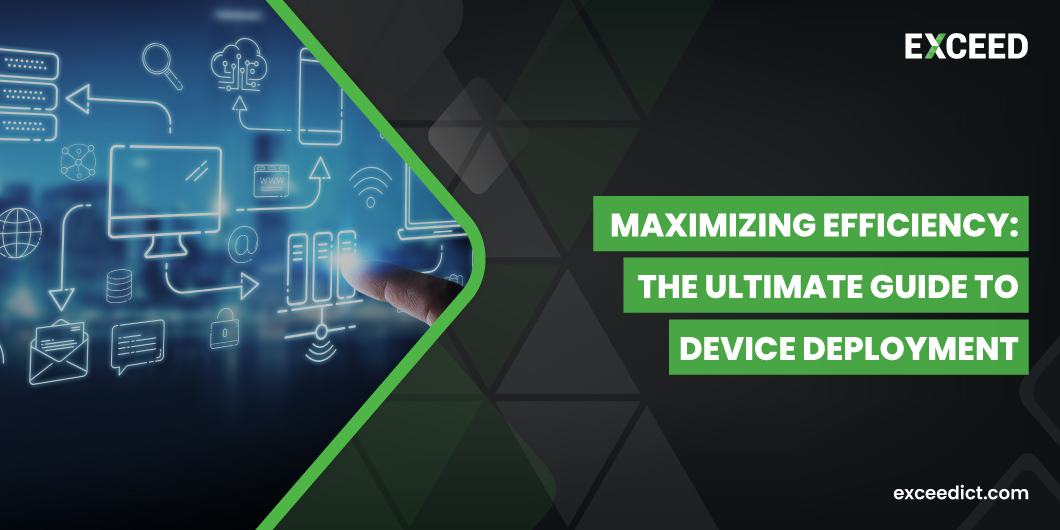
What Is Device Deployment?
 Device deployment is a process of acquiring and configuring devices for use in an organisation. It involves purchasing the right type of hardware, setting up the operating system, installing the necessary applications, and configuring the network and security settings. It also involves training users in how to use the device for their specific needs. Device deployment is essential for businesses that want to stay competitive and efficient.
Device deployment is a process of acquiring and configuring devices for use in an organisation. It involves purchasing the right type of hardware, setting up the operating system, installing the necessary applications, and configuring the network and security settings. It also involves training users in how to use the device for their specific needs. Device deployment is essential for businesses that want to stay competitive and efficient.
Company will need to choose the right type of device, install the necessary applications, and configure the security settings. They will also need to train their staff on how to use the device for their specific needs. Once the device has been successfully deployed, the company can then use it for their daily business operations.
Benefits of Device Deployment
Device deployment can provide a number of benefits to businesses. It can help to reduce the cost of hardware, software, and support, as well as improve the efficiency of the organisation. It can also help to ensure that the devices are secure and compliant with industry regulations. Additionally, it can help to streamline processes and reduce the amount of time spent on managing the devices.
If a company deploys mobile devices, they will be able to access their data from anywhere. This can help to improve their efficiency as they will be able to respond to customer inquiries more quickly. It can also reduce the cost of purchasing and maintaining hardware and software, as the company will only need to purchase and maintain the devices they are deploying.
Considerations When Choosing a Device Deployment Model
 When choosing a device deployment model, there are a number of considerations that need to be taken into account. These include the size and complexity of the organisation, the type of device that is being deployed, and the budget available. Additionally, the company needs to consider the security requirements of the device and the level of support that is required.
When choosing a device deployment model, there are a number of considerations that need to be taken into account. These include the size and complexity of the organisation, the type of device that is being deployed, and the budget available. Additionally, the company needs to consider the security requirements of the device and the level of support that is required.
A company may choose to deploy mobile devices using a bring-your-own-device (BYOD) model. This model allows employees to use their own devices for work purposes, reducing the need for the company to purchase and maintain hardware and software. However, the company needs to ensure that the security settings are adequate and that the devices are compliant with industry regulations.
Identifying the Right Device for Your Business
When choosing a device for deployment, it is important to identify the right device for the organisation’s needs. This requires an understanding of the company’s requirements and the type of device that will support them. For example, if the company needs to deploy mobile devices, then they may need to consider factors such as battery life, screen size, and the type of operating system.
The company should also consider the cost of the device, as well as the cost of maintenance and support. Additionally, they should consider the security requirements of the device, as they will need to ensure that the device is secure and compliant with industry regulations. Finally, they should consider the level of support that is required, as this will determine the type of training and documentation that is needed for the team.
Preparing Your Business for Device Deployment
Before deploying a device, it is important to ensure that the organisation is prepared. This includes ensuring that the right type of hardware and software is available, that the network is secure, and that the team is properly trained in how to use and maintain the device.
The company should also ensure that they have a plan in place for how to handle any potential problems that may arise, such as lost devices or malfunctioning hardware. Additionally, they should create a policy that outlines the security and compliance requirements for the device. This will help to ensure that the device is secure and compliant with industry regulations.
Creating a Device Deployment Plan
 Once the organisation is prepared for device deployment, the next step is to create a deployment plan. This plan should include the timeline for purchasing and configuring the devices, as well as the steps for training the team. Additionally, the plan should outline the steps for monitoring and maintaining the devices, as well as troubleshooting any issues that arise.
Once the organisation is prepared for device deployment, the next step is to create a deployment plan. This plan should include the timeline for purchasing and configuring the devices, as well as the steps for training the team. Additionally, the plan should outline the steps for monitoring and maintaining the devices, as well as troubleshooting any issues that arise.
The plan should also include any security requirements that need to be met and any policies that need to be implemented. This will help to ensure that the devices are secure and compliant with industry regulations. Finally, the plan should include a timeline for when the deployment will be completed and how the team will be monitored and supported during the deployment process.
Implementing a Device Deployment Strategy
Once the device deployment plan is in place, the next step is to implement the strategy. This involves purchasing and configuring the devices, as well as setting up the network and security settings. Additionally, the team needs to be trained on how to use the device for their specific needs.
It is also important to monitor and maintain the devices to ensure that they are running smoothly and that any potential problems are identified and addressed quickly. Additionally, the team should be trained in troubleshooting common issues and best practices for securely managing device deployment.
Monitoring and Maintaining Device Deployment
Once the device has been successfully deployed, it is important to monitor and maintain the device. This includes ensuring that the device is updated with the latest security patches and that any potential issues are identified and addressed quickly. Additionally, the team should be trained in troubleshooting common issues and best practices for securely managing device deployment.
It is also important to regularly review the security settings to ensure that the device is compliant with industry regulations. Additionally, the team should be trained in best practices for securely managing device deployment. Finally, the organisation should monitor the usage of the device to ensure that it is being used in accordance with the company’s policies.
Troubleshooting Common Challenges with Device Deployment
When deploying a device, it is important to be prepared for any potential issues that may arise. It is important to have a plan in place for how to identify and address any issues quickly. Additionally, the team should be trained in troubleshooting common issues and best practices for securely managing device deployment.
Common issues that may arise include lost or stolen devices, malfunctioning hardware, or problems with the network or security settings. In these cases, it is important to have a plan in place for how to identify and address the issue quickly. Additionally, the team should be trained in troubleshooting common issues and best practices for securely managing device deployment.
Best Practices for Device Deployment in Australia
When deploying a device in Australia, it is important to adhere to best practices. This includes ensuring that the device is secure and compliant with all relevant industry regulations. Additionally, the team should be trained in best practices for securely managing device deployment.
It is also important to ensure that the device is updated with the latest security patches. Additionally, the team should be trained in best practices for securely managing device deployment and troubleshooting common issues. Finally, the organisation should monitor the usage of the device to ensure that it is being used in accordance with the company’s policies.
Securely Managing Device Deployment
When deploying a device, it is important to ensure that the device is secure. This includes setting up the necessary security settings and regularly updating the device with the latest security patches. Additionally, the team should be trained in best practices for securely managing device deployment and troubleshooting common issues.
It is also important to ensure that the device is compliant with all relevant industry regulations. This can be done by regularly reviewing the security settings and ensuring that the device is configured correctly. Finally, the organisation should monitor the usage of the device to ensure that it is being used in accordance with the company’s policies.
Automating Device Deployment
Automating device deployment can help to reduce the time and effort required to deploy devices. This can be done by using software to automatically configure the device, install the necessary applications, and set up the security settings. Additionally, the software can be used to monitor and maintain the device, as well as troubleshoot any issues that arise.
Automating device deployment can also help to ensure that the device is secure and compliant with industry regulations. Additionally, it can help to ensure that the device is updated with the latest security patches and that the team is properly trained in how to use and maintain the device. Finally, it can help to reduce the cost of hardware, software, and support, as well as improve the efficiency of the organisation.
Frequently Asked Questions:
What is Device Deployment?
Answer: Device deployment is the process of provisioning and configuring hardware and software on individual devices, such as computers and mobile devices, so they can be used in an organisation’s IT environment.
What are the Benefits of Device Deployment?
Answer: Device deployment refers to the process of setting up and installing devices, such as computers, smartphones, and tablets, for use in an organisation.
The benefits of device deployment include:
- Improved productivity: Device deployment ensures that employees have access to the necessary hardware and software to perform their job functions, leading to increased productivity.
- Enhanced security: Proper device deployment ensures that security measures such as firewalls, antivirus software, and data encryption are in place, reducing the risk of data breaches and other security threats.
- Cost-effectiveness: Effective device deployment can lead to cost savings in the long run, as it minimizes the need for constant repairs and replacements.
- Standardization: Device deployment can ensure standardization of hardware and software across an organisation, which can simplify troubleshooting and reduce confusion among employees.
What are the Steps in a Device Deployment Process?
The device deployment process typically involves the following steps:
- Planning: Determine the type and number of devices needed, the hardware and software requirements, and the budget.
- Preparation: Prepare the devices by installing the necessary software and configuring the settings.
- Testing: Test the devices to ensure that they are functioning properly and can be integrated into the organisation’s network.
- Deployment: Deploy the devices to their intended users and ensure that they have the necessary training and support to use them effectively.
- Maintenance: Provide ongoing maintenance and support for the devices to ensure that they continue to function properly.
What are the Different Types of Device Deployment?
There are different types of device deployment, including:
- Mass deployment: Deploying a large number of devices simultaneously, typically using automated tools.
- Staged deployment: Deploying devices in stages, which can help manage the workload and identify and resolve issues before the next stage of deployment.
- Pilot deployment: Deploying a limited number of devices to a select group of users to test the deployment process and identify potential issues.
What are the Challenges of Device Deployment?
The challenges of device deployment can include:
- Compatibility issues: Ensuring that the devices and software are compatible with each other and with the organisation’s network.
- Data migration: Transferring data from existing devices to new devices without losing any data or disrupting productivity.
- User adoption: Ensuring that users are trained and comfortable with using the new devices and software.
- Security risks: Ensuring that the new devices and software do not introduce any security risks or vulnerabilities.
- Logistics: Managing the logistics of deploying and maintaining a large number of devices can be challenging and time-consuming.
Check out this link to learn how Device Deployment can help you grow your business with Exceed ICT! From modernizing your tech to streamlining processes, there’s so much to gain. Come explore and see for yourself!
Connect with us on our social networks from footer and stay updated with the latest news from Exceed ICT PTY LTD. Join us today! Share your experience with us!
Rate us on Google Maps and help us continue to improve our services for you.


